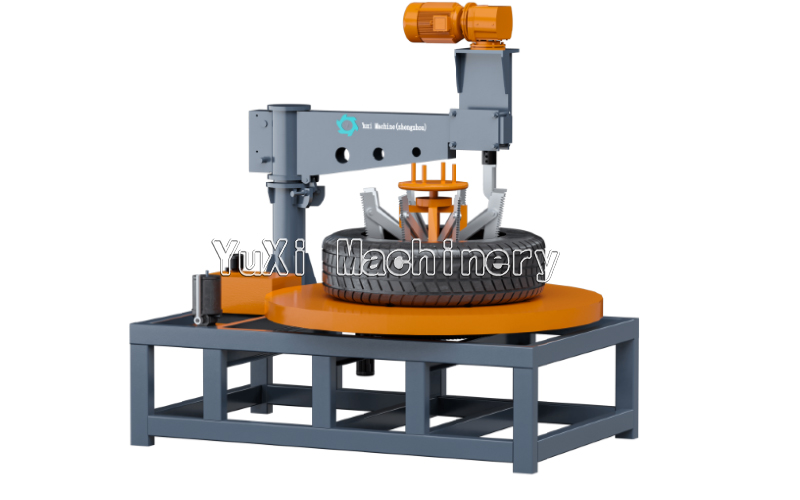With the global pressure of disposing over 1.5 billion scrap tires annually, tackling “black pollution” remains a core challenge in environmental protection and resource circularity. The high-strength steel wire in tire beads is the “tough nut” hindering efficient scrap tire recycling: manual disassembly is slow, residual steel wire damages downstream equipment, and rubber resources are wasted. The scrap tire bead cutter emerges as a targeted solution, becoming an indispensable “game-changer” in the tire recycling industry chain.
It is a specialized device designed for scrap tire preprocessing, with the core function of precisely cutting the high-strength steel wire in tire beads to separate the tire body from the steel wire.
In traditional tire recycling, tire bead steel wire—due to its high hardness and tight bonding with rubber—takes over 30 minutes to disassemble manually per tire, with residual steel wire fragments common. The bead cutter, via automated mechanical operation, eliminates obstacles to subsequent crushing and rubber processing, and solves the industry-wide problem of “hard-to-handle, hard-to-separate” tire bead steel wire. It is a “critical front-end device” for tire resource recycling.

The bead cutter is compatible with most types of scrap tires, including:
Any tire (from household car tires to heavy-duty engineering tires) with a bead steel wire structure can be efficiently separated by this device.
The bead cutter’s workflow consists of 4 automated core steps: Positioning → Cutting → Separation → Discharge:

Compared to manual disassembly or traditional rough processing, the bead cutter’s advantages span efficiency, cost, and adaptability:
1.Precision & Efficiency, Significant Production Boost
Precise positioning technology + minimal cutting error allow bead cutting for a single tire to be completed in just 1 minute—over 30x faster than manual operation—directly increasing the capacity of the entire recycling line.
2.High Durability, Lower Operation & Maintenance Costs
The cutter is made of AISI D2-grade high-strength alloy, which is wear-resistant and impact-resistant. It can process over 100,000 tires continuously without significant wear, reducing the frequency of replacing vulnerable parts and lowering long-term operation costs.
3.Easy Operation, High Safety
The device adopts OSHA (Occupational Safety and Health Administration)-certified one-button operation + safety protection systems. Even new operators can master the process quickly, while avoiding safety risks (e.g., scratches, impacts) associated with manual disassembly.
4.Wide Adaptability, No Frequent Mold Changes
The clamping mechanism’s adjustable size range (12–24 inches, meeting North American tire specification standards) supports multiple tire sizes, eliminating the need for frequent mold changes and adapting to different recycling scenarios.
5.Aids Recycling, Improves Resource Utilization
Pre-separating bead steel wire reduces wear on downstream crushing equipment and enables separate recycling of steel wire resources (meeting EPA (Environmental Protection Agency) resource recycling standards), enhancing resource utilization across the entire recycling chain.
Driven by European and American circular economy policies and carbon reduction goals, scrap tire recycling has shifted from “rough crushing” to “refined sorting.” The bead cutter not only solves the technical pain point of bead steel wire separation but also enables dual-resource recycling of “rubber + steel wire,” pushing the industry from “hazard-free disposal” to “high-value resource utilization.”
For small and medium-sized recycling enterprises, a single bead cutter can quickly improve preprocessing efficiency and reduce labor costs. For large-scale recycling projects, it is a core front-end device for building “large-scale, automated recycling lines”—it can be said that the bead cutter is becoming a “standard” in the European and American tire recycling industry.